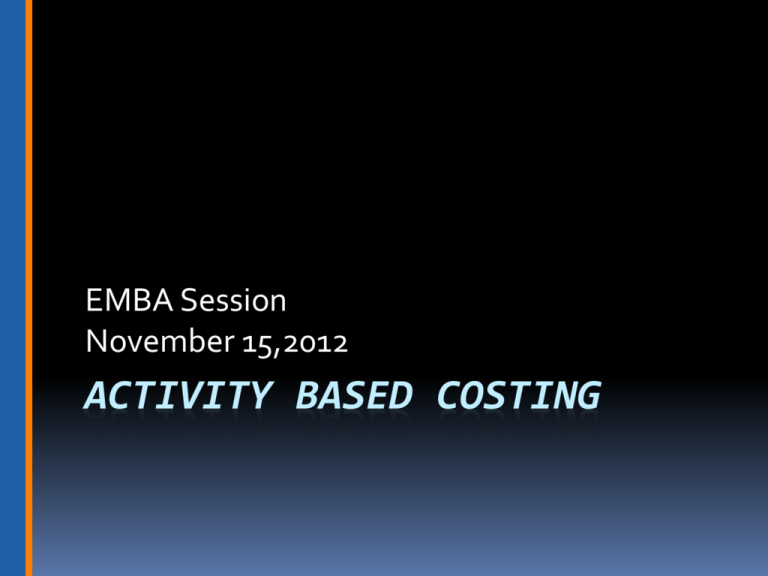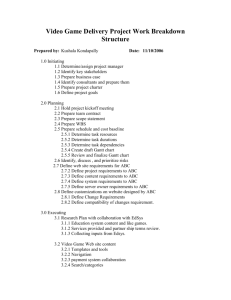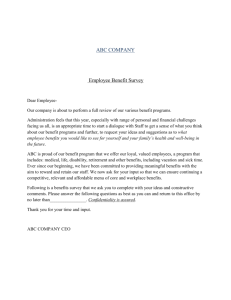Types of Costs and Cost Accounting Systems
advertisement

EMBA Session November 15,2012 ACTIVITY BASED COSTING Overview of Lecture Review of cost behaviors Rationale for ABC approach Factors supporting an ABC system Cost flows Steps in implementation Examples Level of acceptance of ABC costing Types of Costs Fixed costs Variable costs Mixed costs Relating Costs to Objectives Traceable costs Direct labor Direct material Allocated costs Fixed overhead Variable overhead Traditional Allocation Method Warehousing Product A Engineering Purchasing Maintenance Direct Labor Hours Product B Rational for ABC Approach Single allocation rate not sufficient Currently many firms must target price their products ABC assists in target pricing Advent of high speed computing power made ABC feasible Environmental Factors Supporting ABC Approach High levels of competition Very diverse product mix Low cost of measurement for additional data required ABC Cost Flow Schematic Purchasing Purchase Orders Warehouse Product A Number of Receipts Product B Engineering Number of Hours Maintenance Number of Hours Implementation Steps Identify the cost objectives Identify the direct costs of the products Identify the overhead cost pools Select the appropriate drivers Test the assumptions Install Example of Product Costing Raw Materials Department $1,000,000 Raw Material $150,000 15,000 Receipts Product A Purchased Parts $600,000 1,000 Receipts Product B Material Movements 250,000 250 Setups Product C Product D Allocation Using Single Driver $1,000,000 16,000 Receipts = $62.50 per receipt Product A B C D No. of Receipts 4,040 6,200 2,000 3,750 16,000 Rate $62.50 $62.50 $62.50 $62.50 Allocated Cost $252,500 387,500 125,000 235,000 $1,000,000 Calculation of Multiple Rates Pool Dollars No. of Drivers $ 150,000 15,000 $10 Per Receipt Purchased Parts 600,000 1,000 $600 Per Receipt Material Handling 250,000 250 Cost Pool Raw Material $1,000,000 Per Driver Driver $1,000 Per Setup Use of Activities by Products Products Raw Materials Number Rate Purchased Parts Number Rate Setups Number Rate A 4,000 $10 40 $600 50 $1,000 B 6,000 $10 200 $600 80 $1,000 C 1,500 $10 500 $600 70 $1,000 D 3,500 $10 260 $600 50 $1,000 Totals 15,000 1,000 250 Allocation to Products A Raw Materials B C D Total $ 40,000 $ 60,000 $ 15,000 $ 35,000 $ 150,000 Purchased Parts 24,000 120,000 300,000 156,000 600,000 Material Handling 50,000 80,000 70,000 50,000 250,000 Totals $ 114,000 $ 260,000 $ 385,000 $ 241,000 $ 1,000,000 Comparison of Two Methods Product Traditional ABC Method Variance A $ 252,500 $ 114,000 $ 138,500 Over B 387,500 260,000 127,500 Over C 125,000 385,000 260,000 Under D 235,000 241,000 6,000 Under $1,000,000 $1,000,000 Totals $ 0 Retail Example of ABC Costing Traditional Allocation Soft Drinks Percent of Sale Sales 19.30% Operating Income as Percent of Sales 51.20% Package Goods Totals 29.50% 100.00% $ 26,450 $ 70,020 $ 40,330 $ 136,800 20,000 5,790 25,790 50,000 15,360 65,360 30,000 8,850 38,850 100,000 30,000 130,000 660 $ 4,660 $ 1,480 Costs: Cost of Goods Sold Store Support Costs Totals Operating Income Fresh Produce $ 0.0250 0.0666 0.0367 $ 6,800 0.0497 Identify Cost Pools and Drivers Activity Driver Ordering # of P.O. $5,200 52 $100 Delivery # of Del. $8,400 105 $ 80 Stocking # of L.H. $5,760 280 $ 20 $10,240 51,200 .20 Cust. Sup. # of Items Bottle Return Total Cost Pool No. of Cost per Drivers Driver $400 $30,000 New Cost Drivers Activity Cost Per Driver Soft Fresh Package Drinks Produce Goods Totals Ordering $100 per P. O. 12 28 12 52 Delivery $80 per delivery 10 73 22 105 Stocking $20 per labor hour 18 180 90 288 Customer Support $.20 per item sold 4,200 36,800 10,200 51,200 Bottle Return Direct allocation $400 $400 Results Applying ABC Soft Drinks Fresh Produce Package Goods Totals Sales Costs: Cost of sales Bottle return Ordering Delivery Stocking Customer support Totals $ 26,450 $ 70,020 $ 40,330 $ 136,800 20,000 400 1,200 800 360 840 23,600 50,000 30,000 2,800 5,840 3,600 7,360 69,600 1,200 1,760 1,800 2,040 36,800 100,000 400 5,200 8,400 5,760 10,240 130,000 Operating Income $ Percent of Operating Income to Sales 2,850 0.1078 $ 420 0.0060 $ 3,530 0.0875 $ 6,800 0.0497 Acceptance of ABC Costing Approximately 60% of manufacturing firms in the US have tried ABC 10%-20% finally kept it in place Reasons for rejection: Cost of gathering information Complexity outweighs usefulness Disagreement on proper drivers Copyright by Frank Ilett, 2012






